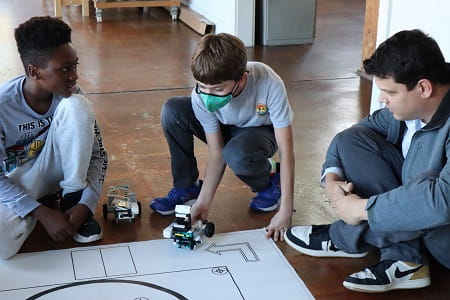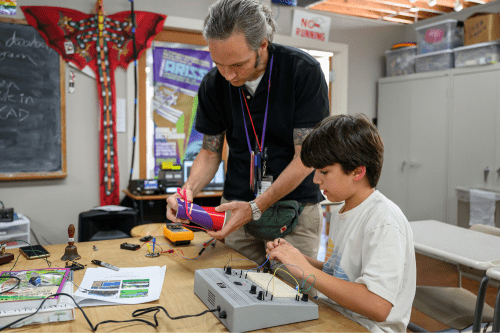In 2016, St. Stephen’s Episcopal School in Houston TX, committed to creating a STEM community—the da Vinci Lab for Creative Arts & Sciences. The makerspace is shared with local schools, in addition to St. Stephen’s own students. This year with a grant from a local law firm, the da Vinci lab was able to expand its robotics program into every classroom. Originally, the da Vinci Lab mainly hosted classes within the makerspace, but quickly became a push-in program so Kindergarten teachers could collaborate with lab instructors to deliver developmentally appropriate hands-on STEM activities.
Charlie Larrabee, da Vinci Lab instructor, and Matt Beard, robotics instructor, were kind enough to make time in their busy day to share their successes and challenges so Montessori schools can get a glimpse into designing and running a makerspace of their own.
V. Kulikow: How do students—youngest to oldest—interact with the makerspace?
Charlie Larrabee:
My youngest group is Kindergarten and we run da Vinci lab projects in their homeroom, because it’s a familiar setting. Starting in first grade we meet in the lab. That’s where the kids work on touch-typing, programming, 3D design, and electronics. Typically, I will have meetings with the homeroom teachers and discuss what type of things they are working on in their curriculum. Right now, we are doing bridge design, so I also want to talk to the kids about triangles, because they need to be thinking about triangles as they’re designing their tresses. The hope is to have some tie-in and if it doesn’t happen at the same time, then at least I make sure I’m using the same words that they use in their homeroom.
Matt Beard:
I’m the middle years humanities teacher as well, and a lot of times in robotics the sort of grander task that we’re working towards in our bigger projects are inspired by real-world events. For instance, we have a mat that features a number of elements like PVC couplings, different colored checkers, and that sort of thing. One of the tasks was inspired by the Fukushima nuclear reactor cleanup. Different colored elements represent radioactive elements vs. inert elements. Different zones on the map mirror the real-life cleanup that was done by having to move elements to where they’d be safe and where they’d be handled properly. We always have an eye on current events and real-world applications.
V. Kulikow: What are the greatest challenges in running the Lab?
Matt:
 For robotics, it seems that there are some students who come in with lots of Lego experience or programming background, but can’t always hit the ground running to build and program amazing machines right off the bat. Usually around the first task—where they have absolute freedom to build a robot of their own design—students can experience frustration that will mount when they start to program their robot and realize that the build they created is not going to work. Dealing with that frustration and helping students work through that rather than throw their hands up has probably been the greatest challenge. Thankfully, this far into the year, the issue is largely in the rearview mirror. They’re fine moving forward.
For robotics, it seems that there are some students who come in with lots of Lego experience or programming background, but can’t always hit the ground running to build and program amazing machines right off the bat. Usually around the first task—where they have absolute freedom to build a robot of their own design—students can experience frustration that will mount when they start to program their robot and realize that the build they created is not going to work. Dealing with that frustration and helping students work through that rather than throw their hands up has probably been the greatest challenge. Thankfully, this far into the year, the issue is largely in the rearview mirror. They’re fine moving forward.
Charlie:
Relating to that, my biggest challenge is typically getting kids to engage deeply with their work. A lot of my students say they’ve already made a 3D design of something or that they’ve already done that project. They ask, “What’s next?” Rather than just checking a project off a list, I’m asking them to explore and try something new within the realm of something they’ve done. It can be challenging to pierce the surface.
V. Kulikow: What are the greatest gifts and opportunities with the Lab?
Matt:
As I mentioned before I am the humanities teacher, so I see a lot of students in an English, history, or geography setting. The students who often times struggle in those types of classes— when they get their hands on a robot that is always practical and always hands-on and they’re not dealing with as much abstraction—those kids can really find their niche and thrive in a way that I don’t get to see to that degree in a different environment. It’s always nice to see the students from a little different angle.
Charlie:
One of the greatest assets to my program is the flexibility in curriculum to take a big opportunity when it comes up. For instance, just over a month ago we had contact with the international space station. That whole event and planning took over the curriculum for a while and that was okay. We made it into a big event where the kids learned all about satellites, radios, and how radio antennas work. We also launched some weather balloons that flew around the earth twice. All these things are connected to that space station concept. Being able to take the opportunity and run with it was a huge success.
Matt:
The contact was so cool. The kids were excited. You could feel the electricity leading up for days.
Charlie:
Not many schools get to do the scheduled contact; only eight schools in the United States per semester. Of those eight schools it’s probably less than half that get to do a direct contact, which means we built the station and the antennas that are up on the roof of our school. The kids tested the field strength of the antennas in the classroom before they were installed on the roof. They’ve even controlled the tracking mount that moves the antennas. Very few schools actually build their station in the school. We did it that way so the kids are literally speaking to space, straight overhead, as if they are on a walkie-talkie. We’re continuing to use the antenna to track other amateur satellites. Rice University, which is right down the street, asked us to help track its amateur satellite once it’s up in the air this spring.
V. Kulikow: Any advice to other schools looking to create a STEM makerspace?
Matt:
I think that the breadth of everything achievable with tech means you have so many options—make it fun. Come in with intentionality, come in with a game plan and have fun activities planned. The kids will be right there with you. But be prepared for snafus—things are not always going to work out perfectly. That’s not the end of the world, just be flexible.
Charlie:
I agree with that 100%. The other thing that can be tricky for new makerspaces or technology programs is that there is a lot of great material for teachers to use. It can be overwhelming. My advice would be to check in with other schools that are doing a similar program and find out what’s been successful for them. I love meeting with other makerspace teachers to see how they run their setup—everybody does it a little bit differently. But there’s so much knowledge to be gained just by word of mouth.
Interested in writing a guest post for our blog? Let us know!
The opinions expressed in Montessori Life are those of the authors and do not necessarily represent the position of AMS.


